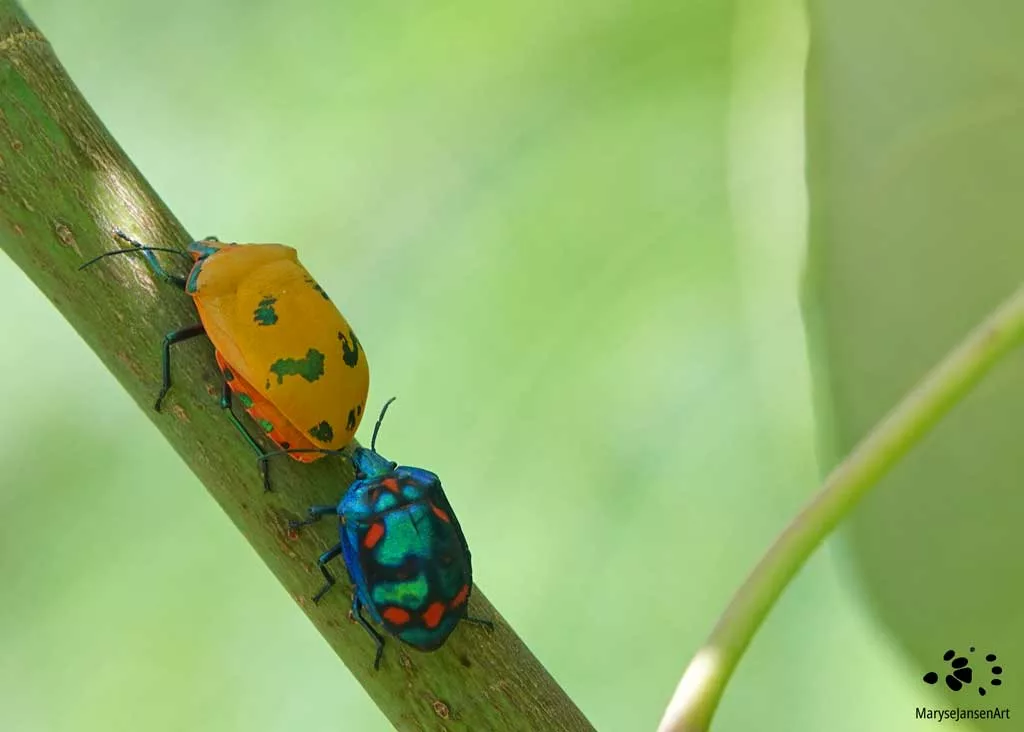Wildlife Photography with marysejansenart
Aggregations in the Cotton Tree
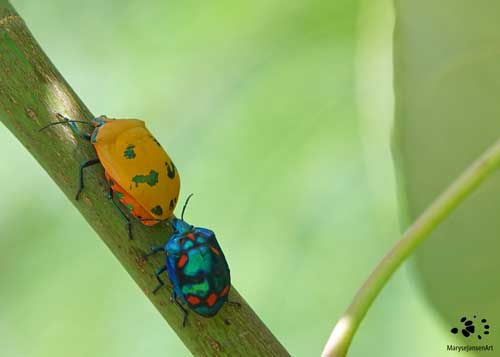
I stop and admire the yellow flowers on the Coastal Hibiscus, also known as Cotton Tree or Cottonwood. A bright orange creature attracts my attention. There’s two of them, sitting right there on the flower base! Upon closer examination I notice that they have small metallic blue patches on their orange shield. These are Cotton Harlequin Bugs!
Table of Contents
Stink Bugs and Jewel Bugs
Cotton Harlequin Bugs are also sometimes referred to as stink bugs. They are not actually Stink Bugs as those are a different species. But ‘stink bug’ is used as a common name that could refer to several species of bugs.
In the Brisbane area alone, several dozens of species are called stink bug, eg. the Bronze Orange Bug, the Green Jewel Bug, the Acacia Shield Bug, the Common Gum Tree Shield Bug, the Red Green Spined Stink Bug and many more. They all have in common that they excrete chemicals with a foul smell when crushed or disturbed. Not only does it smell, it can also irritate your eyes and your skin, so I opt to leave them alone and just admire their beauty.
The Cotton Harlequin Bug is a member of the Jewel Bug family. Jewel Bugs are known for their beautiful, bright, shiny metallic colours. The name Metallic Shield Bugs is also used for this family and refers to the continuous shield that covers their abdomen and their wings. It does not split open when they take flight as happens with beetles.
Amazing colour variations in Cotton Harlequin Bugs
I spot a couple more bugs, these ones are notably smaller and different in shape and colour. They are mainly metallic blue with some bright red patches. Definitely another Jewel Bug. But actually, surprisingly, these are also Cotton Harlequin Bugs!
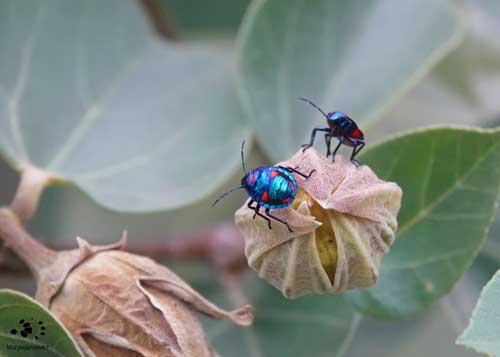
The males and females of this species look completely different, and the nymphs are different again. You can imagine there has been some confusion in the past around identification. It was not until 2006 that scientists confirmed that they were all colour variations of one single species! The females are orange and the males are blue and red. Individual males can also vary a lot in the patterning of their colours. Some are more red and others more blue. Nymphs change colour in different stages and may even show variations of metallic green and purple!
There are also differences between individuals, based on their latitude! In temperate areas the females have more and larger metallic blue patches then in the subtropics. Temperate males are mostly blue-green with small red patches whereas subtropical males are red with metallic blue patches.
Clustering in the Cotton Tree
Cotton Harlequin Bugs are mainly found in eastern Australia and also across large parts of northern Australia. They can be found in coastal areas as well as urban and agricultural areas. You may also find them in the park or in your garden.
They feed by piercing the stems and sucking the sugar-rich juices from young shoots of various Hibiscus species. They also like the Cotton Plant. The Cotton Plant is related to Hibiscus, but note that it is not the same as the Cotton Tree that I’ve spotted these bugs on.
A female lays her eggs in a cluster around a stem on the host plant. The eggs look like little pink balls. She guards them until they hatch. This level of maternal care is unusual in bugs and it is specific for Jewel Bugs. The nymphs have to go through a number of stages called instars before they molt into their mature form (click here to read about another insect that molts multiple times until it reaches its adult form). During this time they are more vulnerable as they don’t have wings yet.
The nymphs stay in a cluster, also called an aggregation. It is a matter of safety in numbers: the intensity of the pungent chemicals that they release as a group will be a lot more effective then when they do it on their own. I find an aggregation on the underside of one of the leaves of the Cotton Tree. It is a most fascinating sight! It makes for an amazing Nature-bite!
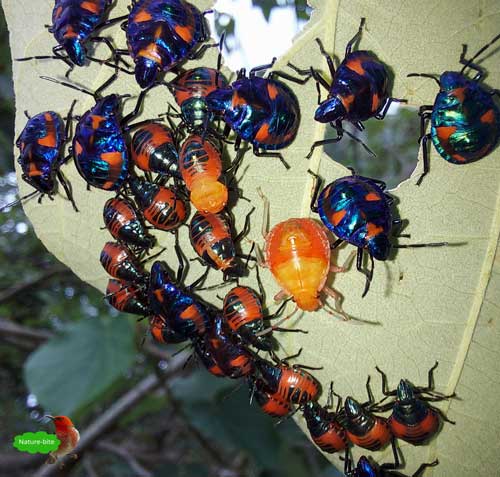
Harlequin Bugs Cluster
A natural wonder hidden in plain sight
While I’m working on this post I take a morning stroll along a busy esplanade. I didn’t intend it to be a nature walk, but still there is plenty to see. I notice there are a lot of Cotton Trees in this area and I wonder if I might find more Cotton Harlequin Bugs. I’ve probably passed a good twenty trees without any success before I see them.
One particular tree seems to be popular with the bugs. I spot a lot of individuals spread out over the tree. I wonder if I could find a cluster. You have to look for these on the underside of the leaves, where it’s shady and out of the direct line of sight of predators. The longer I look, the more clusters I find! I see nymphs in various stages, from really tiny to almost adult size. And I even spot a female sitting on a cluster of eggs! Amazing!
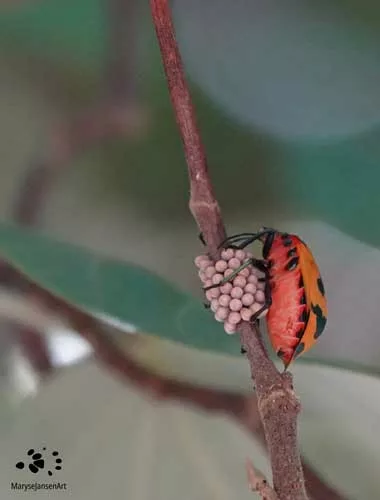
The wind, nor the fact that they hide in these dark spots, is making it easy for me to take good photos… but nevertheless it is a great opportunity to get some extra photos to illustrate this post!
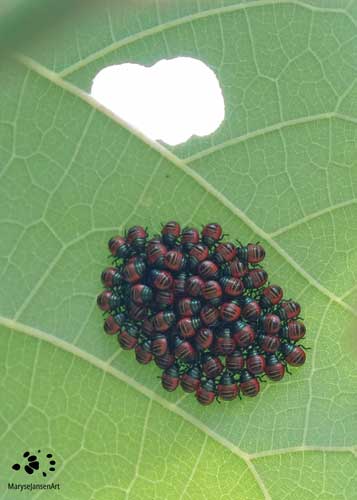
Other people just wander past, chatting with each other or walking their dogs. They have no idea of what is going on in this tree. If I hadn’t been studying these bugs this week I probably would have walked straight past this natural wonder as well!
It goes to show that you see so much more when you know what you’re looking for! It is the reason I write this blog: I want to share my experiences and my knowledge with you, so that you can also get much more joy out of a nature walk! The other thing to always bring is all your senses and your curiosity (read more about that here) Keep exploring and keep learning and it will give you great satisfaction!
Join me on my walk where I spotted some Cotton Harlequin Bugs in the latest episode of ‘Come for a walk in the Australian Bush’ below:
If you are interested in purchasing a print of ‘Cotton Harlequin Bug Pair’ or would like to see what the image looks like on the various merchandise products, please head to my shop. For ‘Cotton Harlequin Bugs’, click here.

